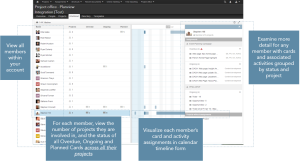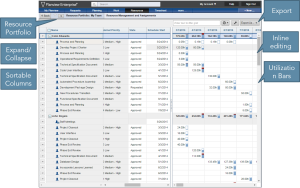
Whether you are managing day-to-day projects in a 20-person company or managing 20+ projects per year in a highly evolved enterprise, you know it’s essential to understand resource commitments and work across projects. But do you need resource management or workload management
Depending on your organization’s size, project portfolio complexity, number of projects, and needs, there are different solutions that can help you and your team execute on projects and achieve strategic objectives. This blog will quickly explain the difference between workload management offered in project collaboration tools, like Projectplace, and portfolio and resource management solutions, like Planview Enterprise.
As you can see in this table, workload management is for those who just need to know how busy their team members are so they can get projects done. Resource management is for those who need more quantifiable data, such as what percentage their resources are utilized.
Figure 1: Modern teams want one online workspace (2015); Source: North America Survey of 200 business project collaborators conducted by Appleseed Partners and commissioned by Planview
Workload Management for the Accidental Project Manager is High Level and Qualitative
Compared to most certified, full-time project managers, many “accidental project managers” have two jobs – their day job and their incidental role managing projects ad hoc. These professionals need to quickly develop project plans and bring the team together – they manage on the fly, committing just 30 to 45 minutes per day to project management tools. For them, workload management capabilities mean they can adapt to change and determine who is available for work quickly (Figure 1).
Resource Management for Project Managers and PMOs is Analytical and Quantitative
Certified project managers must ensure they have the right people based on a variety of factors such as skill sets, availability, license to work, ability to communicate…whatever the project requires. They need a dynamic view into all resources across project teams, departments, the enterprise, geographies, and internal vs. external pools. In addition, project type is an issue, including whether it is collaborative, agile, or structured. The project managers must consider every permutation to make the best decision for each project. For this level of project complexity, resource management capabilities are ideal.
Resource management capabilities deliver an in-depth precision that supplies a quantitative view of resources. As a result project owners gain a unique visibility into all resources and capacity across the enterprise.
Scaling Your Organizational Maturity
For many groups, obtaining workload visibility is the jumping off point. There is always room to scale your organizational maturity. As the business grows, project leaders will begin juggling more projects, more people, and more moving parts – resulting in the need to integrate these capabilities to better optimize resources and work with a view into a single portfolio.
Based on the information I provided, do you need resource management or workload management? Share your use case for each by leaving a comment below.


![Project Management Software: Chaotic Ways of Working [Video]](https://blog.planview.com/wp-content/uploads/2017/08/Chaotic-Ways-of-Working-2.jpg)



